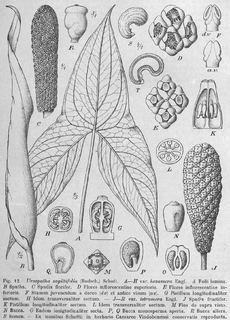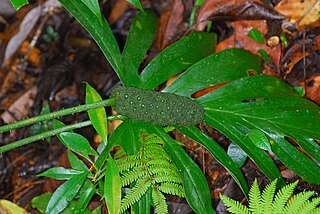
Anthurium, is a genus of about 1000 species of flowering plants, the largest genus of the arum family, Araceae. General common names include anthurium, tailflower, flamingo flower, and laceleaf.

Peltandra, the arrow arums, is a genus of plants in the family Araceae. It is native to the eastern United States, eastern Canada, and Cuba.
- Peltandra sagittifolia - (Michx.) Morong - Spoon flower or the white arrow arum - southeastern US from eastern Louisiana to Virginia
- Peltandra virginica(L.) Schott - Arum arrow - Cuba, Quebec, Ontario, Oregon, California, Washington; eastern US from Maine to Florida, west to Texas, Kansas, and Minnesota
- †Peltandra primaeva – Eocene, Golden Valley Formation, North Dakota, USA

Spathiphyllum montanum is a flowering plant of the genus Spathiphyllum in the family Araceae. It is native to Panama and Costa Rica.

Callopsis is a monotypic genus from the plant family Araceae and has only one species, Callopsis volkensii. This plant forms a creeping rhizome and has cordate-ovate leaves that are medium green and glaborous. The inflorescence is typical of the family Araceae, with a white spathe and yellow spadix. The spadix is shorter than the spathe and its male and female flowers are separated shortly.

Arisarum is a genus of flowering plants in the family Araceae. It is native to the Mediterranean region, east to the Caucasus and west to Macaronesia.

Pothoidium is a monotypic genus of flowering plants in the family Araceae. The single species that comprises the genus is Pothoidium lobbianum. This species is native to Maluku, Sulawesi, the Philippines, and to Lan Yü Island of Taiwan.

Holochlamys is a monotypic genus of flowering plants in the family Araceae. Holochlamys beccarii is the only species in the genus Holochlamys. It is native to New Guinea and the Bismarck Archipelago and is found growing in mud near lowland streams or rocky streambeds at high elevations.
Alloschemone is a genus of evergreen root climbing plants in the family Araceae that is native to the Amazon region of Bolivia and Brazil. There are only two species in the genus and both are extremely rare. These two species are Alloschemone occidentalis and Alloschemone inopinata. At one point in history, the genus Alloschemone was dissolved and added to Scindapsus, but it has since been reinstated after further observations of the plants.

Urospatha is a genus of flowering plants in the family Araceae that consists of approximately 10 known species. They are found growing in South America and Central America in swamps, wet savannahs, and brackish water. The leaves of the species in this genus are upward pointing and sagittate (arrow-shaped). The inflorescences are quite unique; the spathe is mottled and elongated with a spiral twist at the end. The seeds are distributed by water and have a texture similar to cork that allows them to float. They also quickly germinate in water.
Anaphyllopsis is a genus of flowering plants in the family Araceae, native to northern South America.

Anaphyllum is a genus of flowering plants in the family Araceae. It consists of two species. They are found in marshes, have leaves with some pinnation, and have a twisted spathe. The two species in this genus are similar in appearance to those in the genus Anaphyllopsis.
- Anaphyllum beddomeiEngl. - Tamil Nadu, Lakshadweep
- Anaphyllum wightiiSchott. - Kerala, Lakshadweep

Cyrtosperma is a genus of flowering plants in the family Araceae. The genus went through considerable taxonomic changes in the 1980s, and as a result is now considered to be native only to Southeast Asia and some Pacific islands. Previously, the genus was believed to be widespread from Asia to Africa and South America, but the African and South American species were subsequently moved into separate genera. Cyrtosperma is now known to be most prominent in New Guinea. The genus Cyrtosperma is unique in this regards because it is the only known big genus in Araceae that is known to be found east of Wallace's line.

Dracontioides is a genus of flowering plants in the family Araceae. It was long thought to contain only a single species until a second species was described in 2005. Both are endemic to Brazil.

Lasia is a genus of flowering plants in the family Araceae, native to Asia and New Guinea. The genus contains only two known species, Lasia spinosa and Lasia concinna. Lasia was believed to be a monotypic genus until 1997 when a wild population of Lasia concinna was discovered in a farmer's paddy field in West Kalimantan, Indonesia. The farmer had been growing them for their edible young leaves. This species of Lasia had been known of previously only from a single specimen at the Bogor Botanic Gardens, formally described in 1920. Prior to 1997, the specimen was believed to have been a hybrid between Lasia spinosa and Cyrtosperma merkusii. The subsequent discovery by Hambali and Sizemore led to the realization that it was in fact a distinct species.
- Lasia concinnaAlderw. - West Kalimantan
- Lasia spinosa(L.) Thwaites - China, Indian Subcontinent, Indochina, Malaysia, Indonesia, New Guinea
Zomicarpella is a genus of flowering plants in the family Araceae. It is native to Colombia, Peru and Brazil. The leaves are hastate or sagittate. The chromosome number for Zomicarpella species is 2n=26. Additionally, the seeds have an endosperm.
- Zomicarpella amazonicaBogner - Amazonas State of northwestern Brazil
- Zomicarpella maculataN.E.Br. - Colombia, Peru
Phymatarum is a genus of flowering plants in the family Araceae. It contains only one known species, Phymatarum borneense, native to Brunei and Sarawak on the Island of Borneo.
Filarum is a monotypic genus of flowering plants in the family Araceae. The single species making up the genus is Filarum manserichense. It is found growing in the amazonian region of northeastern Peru. Govaerts, R. & Frodin, D.G. (2002). World Checklist and Bibliography of Araceae : 1–560. The Board of Trustees of the Royal Botanic Gardens, Kew. The fertile male flowers of Filarum are unique in that they have hairlike attachment to them.

Pseudohydrosme is a genus of flowering plants in the family Araceae. It contains only two species, Pseudohydrosme buettneri and Pseudohydrosme gabunensis, both endemic to tropical rain forests in Gabon. The genus is believed to be closely related to Anchomanes and is likely to be sunk into Anchomanes due to molecular evidence.
Spathantheum is a genus of flowering plants in the family Araceae. The genus contains two species, Spathantheum fallax and Spathantheum orbignyanum. Spathantheum is believed to be closely related to Spathicarpa. The genus is endemic to the Andes of Peru, Bolivia, and northern Argentina and is found growing in grasslands in rocky soil.
- Spathantheum fallax Hett., Ibisch & E.G.Gonç. - Bolivia
- Spathantheum orbignyanumSchott - Peru, northwestern Argentina, Bolivia

Spathicarpa is a genus of flowering plants in the family Araceae, all of which are endemic to South America. Spathicarpa species are notable for the fact that the entirety of their spadix is fused to the spathe. The genus is believed to be closely related to Spathantheum. The tribe Spathicarpeae is named after the genus Spathicarpa.













